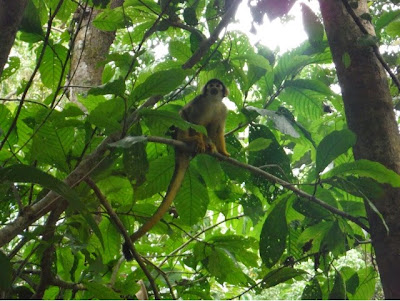Once we scoped out the various jungle excursions available in Puerto Maldonado, we decided to do three days and two nights with Monte Amazonico Lodge. Our guide, Mirko, was one of the best we've had since arriving in South America!
 |
| Ready to see the jungle |
[ clay lick ]
Our itinerary began with an early morning departure from the dock to visit one of the popular clay licks in the area. Waking up at 4:20 a.m. was well worth the experience.
 |
| Heading off at sunrise |
 |
| Look familiar? |
 |
| Making moves |
The clay lick is a place where parakeets, parrots, and macaws gather first thing in the morning to lick clay. There are a few theories on why this occurs. One is that since they consume some toxic fruit in the jungle, they need this clay to neutralize those toxins. Another is that they lick the sodium-rich clay for their diet, as they are not close to any ocean.
 |
| Making their way over |
 |
| Almost there |
 |
| A handy guide |
 |
| Scared away! |
Over the course of two hours waiting near the lick, the birds got spooked several times. They cautiously make their way to the clay since predators like hawks and jaguars may be on the prowl nearby.
 |
| A few blue-headed parrots in the mix |
Most of the parrots and parakeets are green so they do camouflage very well with the surrounding landscape. We were stunned at the amount of birds, in the hundreds, that eventually came to feed.
After the clay lick, we went back to town to pick up the remaining people who would be joining us for the next few days. Then we took an hour long boat ride to the lodge and quickly settled in before taking a hike.
 |
| Caterpillar cuddles |
 |
| Walking palm tree |
 |
| These thorns are used as darts by the indigenous people |
 |
| Strangling tree |
 |
| Huge vines everywhere |
A handful of different species of monkeys were relocated to this island after researchers were done with them 15 or so years ago. The monkeys were eager for the bananas we brought, but waited for the alpha male before proceeding. The alpha male had a big personality and would get jealous easily!
 |
| Feeding a young capuchin monkey |
 |
| Posing for the camera |
 |
| Alpha is not happy |
 |
| This little guy is the last of his species on the island |
[ caiman night tour ]
The caiman in the region vary greatly in size. During our night ride, we saw small dwarf caiman as well as larger black caiman. We even caught a quick glimpse at a massive capybara, but it scurried off before we were able to snap a pic. Capybaras are the largest rodents in the world. Google image search 'capybara' and you'll see that they are larger than many dogs!
 |
| Those eyes |
 |
| Getting a closer look |
 |
| Out and about |
On our third day, we made our way to the reserve around 6 a.m. We had an hour long hike to the lake, where we then took a canoe out to see more wildlife.
 |
| Tambopata National Reserve |
 |
| Creepy crawler |
 |
| Termite mound |
 |
| Another tree older than a century |
 |
| Playing with a giant ant (that does not bite) |
 |
| Looking for parrots |
 |
| Spotted! |
 |
| They love the hollowed out palm trees in the area |
 |
| Perfect place to have a seat |
 |
| Almost to the lake |
 |
| The crew |
 |
| Bats line up this tree to appear larger to predators |
 |
| Rowing through lily pads |
 |
| Two howler monkeys playing around |
 |
| Almost missed that caiman! |
 |
| Happy that the weather cooperated |
[ night hike ]
On our last night, we were all set to scope out the local tarantulas, which are bigger than my hand! Despite the rain, Mirko was able to show us the nocturnal animals lurking around.
 |
| What a tiny frog |
 |
| Bigger than the crickets in Waco |
 |
| Luring a tarantula out |
 |
| Protecting her babies |
 |
| These pinktoe tarantulas make their nests on tree trunks |
No, these were not Halloween decorations! Tarantulas were all around, but very docile. After one last night on the lodge, it was time to leave the heat, insects, and sadly, Mirko.


















.jpg)
















































